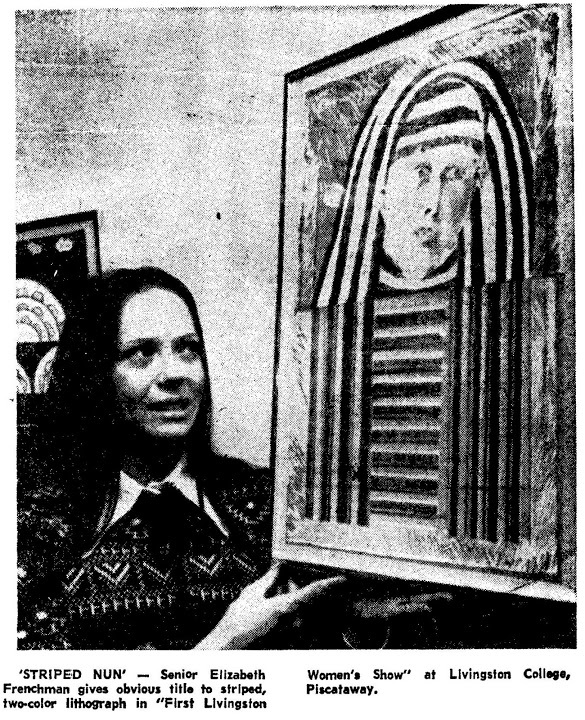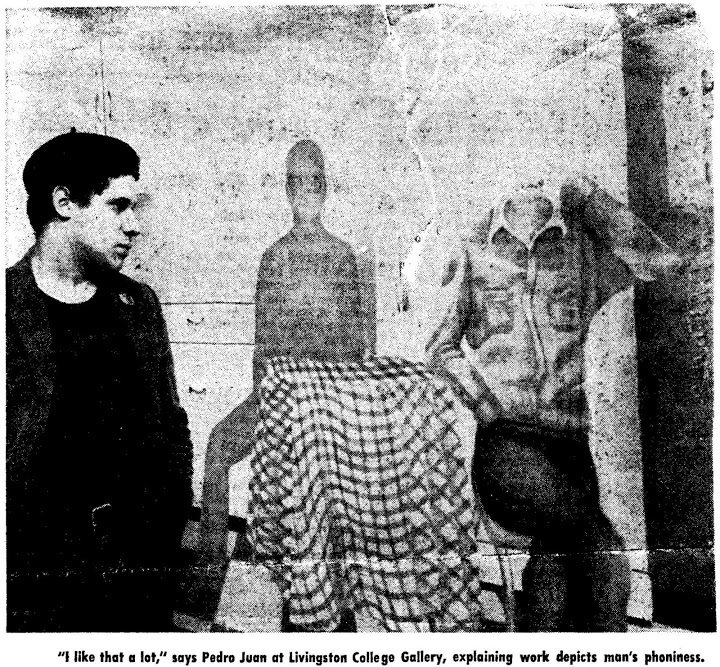Last updated on February 18, 2022
Deborah Stokes, a 1974 graduate of Rutgers University’s Livingston College and a 2015 Livingston College Distinguished Alumna, was one of eight artists exhibiting their works at the “First Livingston Women’s Show” in 1972. She shared the following article documenting the experience (also attached as a PDF file):
 Livingston’s first show by women strictly unpolitical
Livingston’s first show by women strictly unpolitical
PISCATAWAY — Women artists needn’t be women’s libbers.
That’s proved by the “First Livingston Women’s Show” in the Livingston College Art Gallery, which features the work of eight female art students there.
“There is no overt ‘political’ art in the show, and those expecting to see a few fists and 2-D women breaking their chains will be disappointed,” said Elizabeth Frenchman, a senior majoring in lithography, who is showing two amusing color prints and a yellow vinyl “2-D or 3-D stitched sculpture” (with grommets), which at quick glance might be mistaken for an oversize apron.
“The art is women’s art, painted, woven, glazed by women serious about the creative life,” she declared.
This first show by women art students, which closes Thursday, is small, because the gallery in the new academic building complex is small. Competition was ruled out because of the gallery size. The exhibition consists of the work of eight students chosen by instructors in various art disciplines.
Deborah Stokes, senior exhibiting paintings and a silk screen print, prepared the statement denying feminist intention for the show.
Cognizant of today’s transitory American art scene, she pays lip service to feminism in art but makes no commitment.
She explained: “The politics of the Women’s Movement have brought about a new tolerance of diverse life styles, while the American social structure is experiencing a change in identity as women move out of their traditional roles. Increasingly, women are creating the energy for new discoveries in artistic expression.
“For many years women’s artistic outlets have been controlled by the dominant forces in the art world. The Livingston Women’s Show follows the current trend away from the museum aesthetic and moves towards diversity in artistic acceptance. Although a women’s show helps to strengthen an artistic group seeking recognition, women’s art may suffer as much from new categorical definitions as from the old male dominance.”
The Livingston senior feels, “While some women’s art reveals an inherently feminine consciousness through socially influenced subject matter, stylistic elements are universal and cannot be designated exclusively feminine or masculine.”
“Specific media, however, have been traditionally sex-defined,” she said. “The functional art forms, including weaving and ceramics, are only now gradually acquiring the status of other fine arts.”
She pointed out, “Kim Blackburn (sophomore exhibiting weaving and macrame) and Eleanor Fetteroff (junior showing ceramics) consider their pieces to be more than craft.”
The show’s spokesman said Miss Blackburn believes her weaving is “as much an expression of (her) self” and Miss Fetteroff views her raku ceramics as the means to an aesthetic “sensory stimulation.”
 The grotesqueries by Inez Andrucyk, another junior studying ceramics, “are derived from human forms.” These whimsical, non-functional pieces beg to be handled.
The grotesqueries by Inez Andrucyk, another junior studying ceramics, “are derived from human forms.” These whimsical, non-functional pieces beg to be handled.
Bonnie Carlson, a senior showing a big painting with surrealist overtones, so graphic that the stove door handle seems to project from the canvas, makes her eloquent statement as an artist, rather than as a woman.
“I like the paradoxes painting provides, the personal experience turned public. I live working with the two dimensional plane, aiming for the third (perhaps fourth) dimension … my concern is with reality, that level of mystery visible but yet invisible,” she declared.
Puerto Rican-born Pedro Juan, sophomore political science major visiting the gallery, voices a quick, crystal clear interpretation of his own on viewing the kitchen scene that shows a headless man with police cap and full-bodied shadow.
“I like that a lot,” he said of the surrealist painting.
Juan explained, “It symbolized the realities of life. It’s how people see people — the phony person, unreal person. It’s how people really are. They’re phonies.”


